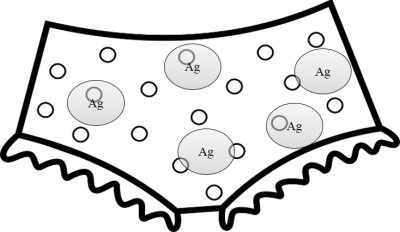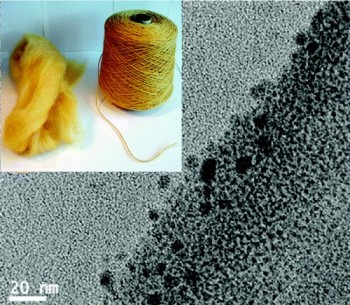A few weeks ago I stumbled across an article about THINX, a new company that is innovating women’s underwear. They are using existing technologies to improve women’s underwear; specifically a special “silver treatment” for its anti-microbial properties. I was very excited about this because I have read about the antibacterial properties of silver, especially silver nanoparticles, and how they are being used in consumer products. (For example, see our post on silver in socks.) Unfortunately, THINX did not provide more information about the technology they were using to make their products so I don’t know for sure whether they’re using nanoparticles or “bulk” silver. This made me wonder, why wasn’t the company more specific about the technology behind their “silver treatment”?

From a company’s perspective I can understand the apprehension about providing details about the technology in their products. Companies may not want to highlight their product’s components for a number of reasons. They may only want to tout their ingredient list when it includes trendy components or follows a current consumer fad, or maybe they don’t want competitors to copy their technology. Another reason is that they might be concerned about consumer backlash. For example, nanoparticles have faced some bad press in Australia, where concerns have been raised that the nanoparticles in sunscreen actually cause cancer.1 The article admits that “no human research supports these harmful health effects,” though, and this concern hasn’t picked up much steam in other places. Studies have shown that titanium oxide nanoparticles do not penetrate skin unless the skin already has damage.2,3

Nevertheless, companies may worry that public fears about nanoparticles will escalate to the same level as the controversy around genetically modified foods. Adverse public reactions about genetically modified foods have manifested themselves from documentaries4 to parenting blogs5; Jimmy Kimmel has even mentioned them6. This is in spite of the fact that about 88% of scientists believe genetically modified foods are safe and studies have shown that they are safe for consumption.7,8 Genetically modified foods are a prime example of why companies may avoid labeling even potentially controversial components on their packaging. While consumer studies show that not much has changed in sales as a result of labeling their products, companies will still have to battle negative perceptions and portrayals in the media.9,10
Although silver particles have been used for their antibacterial properties for years, few companies acknowledge that their products contain nanoparticles. 11 It is possible that companies share the “chemophobia-phobia” discussed in a recent Scientific American piece.12 Survey results from the Royal Society of Chemistry suggest that scientists are concerned about the general public’s ”chemophobia” (a fear of chemistry and chemicals), but that it is not as prevalent as the scientists think. In reality, survey respondents were not that frightened of science and said that they trust chemists and think their work is fascinating. This study highlights the fact that a large portion of the population believes that the science is worthwhile and the benefits outweigh the risks.12 So maybe companies are like the chemists in the survey, and their fears of people’s reactions to nanomaterials are unwarranted or too paranoid.

While there are many benefits to using nanomaterials, which we have discussed in previous posts (e.g. anti-counterfeit technologies; cosmetics; environmental cleanup; food safety; prosthetics; and smog control), a lot of unknowns still remain.14 A fear of adverse public reactions might keep companies from publicizing their use of nanomaterials. All of these factors contribute to why companies may try to avoid dealing with such situations and stay quiet about the use of nanoparticles in their products.
This is complicated by the fact that public opinion is definitely not unified on the issue. For example, Listverse has a list of ten ways nanotechnology will positively revolutionize the world and how we live; 15 at the same time, groups like the Friends of Earth publish reports about the dangers of nanomaterials and claim that the risks do not outweigh the benefits.16 Even if the products are not harmful, confusion and misinformation could lead customers to be afraid of buying them.
So how can we help companies and the public have realistic views of the risks posed by nanoparticles? One important approach is for researchers to help inform the public (both companies and consumers) about scientific discoveries and progress in nanomaterial development so that they can be more informed rather than afraid of new technologies.17,18 Indeed, this is one of the main goals of our blog! Many other organizations are also contributing to the effort to understand public concerns and share current research. For example, the European Parliament Science and Technology Options Assessment created a report to address safety about engineered nanomaterials. They concluded that more policies and regulations are needed, partly because assessing the risks of nanomaterials is so tricky. Many different variables are involved in understanding how various nanoparticles behave, such as their size, shape, core and coating materials, and how they behave at different temperatures or in contact with different materials. Understanding how these and other variables affect nanoparticle behavior (including both what we want them to do and what we want to avoid) is an important motivation for research in the Center for Sustainable Nanotechnology.
The EPA has also turned a lot of its attention to research and tracking the use of nanomaterials in consumer products. Currently, their focus is on tracking where particles are found in the products and how they might get into the environment rather than enforcing labeling.19 Regulations must balance between over-caution that would needlessly limit technological advances, and carelessness that could lead to environmental harm.20
While companies like THINX might debate whether or not to include all the contents of their products on labels, the mission of this blog is to provide information about nanomaterials and scientific discoveries and procedures that pertain to the work we do as a research Center. But in order to help the public stay well informed about how technology is impacting our lives, we need to know what you want to know! We would love it if you, our readers, shared some of your questions, observations, and concerns with us. Use the comments below, the “suggest a topic” button on the left side of this page, or chat with us on Twitter or Facebook. We look forward to hearing from you!
EDUCATIONAL RESOURCES
- American Society of Mechanical Engineers (ASME) educational video podcast on the safe development of nanotechnology
- Vital News Australia. The Controversy Surrounding Sunscreen: Does Sunscreen Cause Cancer? Dec 9, 2012.
- Tucci, P., et al. Metabolic effects of TiO2 nanoparticles, a common component of sunscreens and cosmetics, on human keratinocytes. Cell Death & Disease, 2013, 4, e549. doi: 10.1038/cddis.2013.76
- Sadrieh, N., et al. Lack of significant dermal penetration of titanium dioxide (TiO2) from sunscreen formulations containing nano-and sub-micron-size TiO2 particles. Toxicological Sciences, 2010, 115 (1): 156-166. doi: 10.1093/toxsci/kfq041
- GMO-Awareness.com. Movies to watch – GMO and more. 2011-2014.
- Gunlock, J. “Mommy blogs” and parenting sites take over the fight against GMOs. Genetic Literacy Project. Dec 12, 2013.
- ABC.com. What’s a GMO? Jimmy Kimmel Live, 2014.
- Funk, C. & Rainie, L. Attitudes and Beliefs on Science and Technology Topics. In Pew Research Center, Public and Scientists’ Views on Science and Society, 2015.
- Snell, C., et al. Assessment of the health impact of GM plant diets in long-term and multigenerational animal feeding trials: a literature review. Food and Chemical Toxicology, 2012, 50(3), 1134-1148. doi: 10.1016/j.fct.2011.11.048
- Shepherd-Bailey, J. Economic Assessment: Proposed California Right to Know Genetically Engineered Food Act (Prop 27) Likely to Cause No Change In Food Prices, Minor Litigation Costs, and Negligible Administrative Costs. 2012.
- Aldrich, L. M., & Blisard, N. Consumer acceptance of biotechnology: Lessons from the rBST experience (No. 33663). United States Department of Agriculture, Economic Research, 1998.
- Deardorff, J. Some antibacterials come with worrisome silver lining. Chicago Tribune, Feb 16, 2014.
- Ceci, C. Don’t Let Chemophobia-Phobia Poison Our Communications. Scientific American, Aug 18, 2015.
- Kelly, F. & Johnston, J. Colored and functional silver nanoparticle-wool fiber composites. ACS Applied Materials & Interfaces, 2011, 3(4), 1083-1092. doi: 10.1021/am101224v
- Seltenrich, N. Nanosilver: Weighing the Risks and Benefits. Environmental Health Perspectives, 2013, 121(7) a220. doi: 10.1289/ehp.121-a220
- Rowe, A. 10 Man-Made Nanomaterials With Futuristic Powers. Listverse, May 11, 2015.
- Crocetti, G. & Illuminato, I. Nano-Silver: Policy failure puts public health at risk. Friends of Earth, 2011.
- Fleischer, T. et al. NanoSafety – Risk Governance of Manufactured Nanoparticles: Report on Results of Focus Groups. European Technology Assessment Group, 2011.
- Schuler, E. Perception of Risks and Nanotechnology. In Discovering the Nanoscale, Amsterdam: IOS Press, 2004, 279-284.
- US Environmental Protection Agency. Nanomaterials EPA is Assessing. 2013.
- Fleischer, T. et al. NanoSafety – Risk Governance of Manufactured Nanoparticles Final Report. European Parliament, 2012.

it is a excellent weblog and that i enjoy it very much!